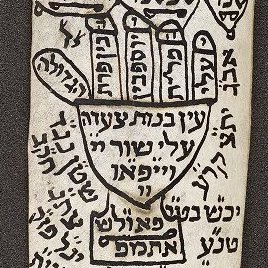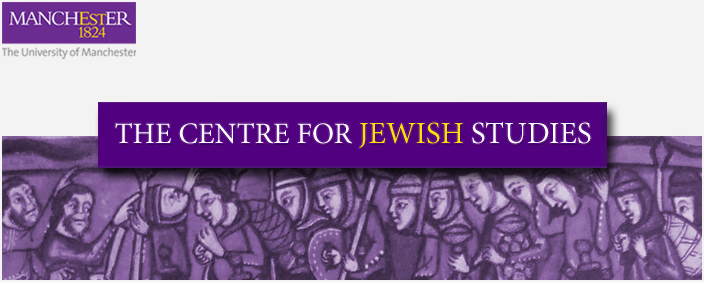Thursday
Dec032020
Artist's Corner: Atar Hadari - Blogpost 2
 Thursday, December 3, 2020 at 3:52PM
Thursday, December 3, 2020 at 3:52PM  Follow Atar Hadari's journey into the 50 Jewish Objects through his own words.
Follow Atar Hadari's journey into the 50 Jewish Objects through his own words.
There’s a Mess in Here But There’s No Messiah
When the idea arose of writing a series of Jewish poems about Jesus, one thing I deliberately avoided was re-reading the New Testament, which I last perused in a hotel edition when I was eighteen in Germany in 1985. (I never made it as far as Revelation but did get through all four of the gospel writers’ accounts.) Re-reading the text would make for critical distance, which is not at all what I was after. What interested me was sifting what had stayed in my mind from hearsay evidence in the culture of England that I have lived in now for forty years. In this essay I would like to acknowledge the popular cultural treatments of the gospels which did, as opposed to those which did not, shape my treatment of the stories.
 The two most widely viewed film treatments in my lifetime have been Scorsese’s adaptation of Nikos Kazantzakis’s novel ‘The Last Temptation’ and Monty Python’s ‘Life of Brian’. Whether it was the casting of Willem Defoe and Harvey Keitel as Jesus and Peter which proved irredeemably earth-bound to my ears, or Scorsese’s visual palette which I find convincing only in urban settings (such as his masterful ‘Age of Innocence’), or perhaps even the secular vision of Kazantzakis’ original novel (which the Vatican did indeed blacklist), for whatever reason I can truly say I found nothing to touch me in Scorsese’s film.
The two most widely viewed film treatments in my lifetime have been Scorsese’s adaptation of Nikos Kazantzakis’s novel ‘The Last Temptation’ and Monty Python’s ‘Life of Brian’. Whether it was the casting of Willem Defoe and Harvey Keitel as Jesus and Peter which proved irredeemably earth-bound to my ears, or Scorsese’s visual palette which I find convincing only in urban settings (such as his masterful ‘Age of Innocence’), or perhaps even the secular vision of Kazantzakis’ original novel (which the Vatican did indeed blacklist), for whatever reason I can truly say I found nothing to touch me in Scorsese’s film. I do remember the controversy around ‘Life of Brian’ and also have a physical memory of laughing myself nearly breathless in the cinema while watching it and finding set pieces like Terry Jones confronting the crowd outside the beleaguered Brian’s window utterly enchanting: ‘There’s a mess in here but there’s no messiah.’ Alas I do not have the intellectual detachment to approach Monty Python’s various writing duos as a role model.
What did suit me as a model was a sketch from John Lloyd’s show ‘Not the Nine O’clock News’ lampooning the televised debate between Malcolm Muggeridge and Bishop Mervyn Stockwood on one side and the rather funnier John Cleese and Michael Palin on the other during the ‘Life of Brian’ controversy. The sketch portrayed a TV debate about ‘the General Synod’s film Life of Christ and its depiction of a humble carpenter called Jesus Christ which some have seen as a thinly veiled and scurrilous attack on the life of Monty Python.’
If I had to define the difference between ‘Life of Brian’ and that sketch I would venture that the Pythons very carefully do not mock the Gospels, while the sketch very successfully mirrors and mocks the responses to the film. My poems are finally about the perceptions and realities of a possible historic event in Palestine of about two thousand years ago. The spirit of that sketch’s controversialist rebuttal guides me, while Monty Python’s own comic but absurdist vision did not. In some curious way I could even argue that the ‘Not the Nine O’Clock News’ team were Anglicans and engaged in a dialogue with the church and its foibles, while Monty Python were much more cerebral. But finally I am interested in mis-understandings, and that is what the sketch is about.
Two other popular treatments in the vernacular have stayed with me. Dennis Potter’s TV play ‘Son of Man’ (1969) predated ‘Life of Brian’ by ten years but was equally controversial. It opens with Colin Blakely – who is rather beefier and indeed corporeal than most actors cast as Jesus, but in this treatment entirely persuasive, because Potter’s language is entirely contemporary and dispenses with the tone which Scorsese attempts, a kind of faux bible English gravitas. Potter’s version (directed by Gareth Davies and perhaps aided by Blakely’s Northern Irish accent) opens with Blakely’s Jesus doubled over on the ground and muttering to himself in possibly messianic doubt, possibly deranged agony: ‘Is it me? Is it me?’. The script proceeds to him being led hooded into the presence of Pontius Pilate and on being unhooded saying ‘Good morning.’ Potter was lambasted but I think his treatment is serious and searching, not absurdist. He reimagines the gospels’ dramatis personae as people speaking today and thereby avoids the main problem with most historic drama. You can believe the people you are hearing and therefore you can think about what they are saying, you can suspend disbelief. Which is what the Mystery Plays were always about.
 Lastly there is Tim Rice’s libretto for ‘Jesus Christ Superstar’ which in its witty lyrics for a host of Jewish characters sets a very high bar for any poet to aspire to:
Lastly there is Tim Rice’s libretto for ‘Jesus Christ Superstar’ which in its witty lyrics for a host of Jewish characters sets a very high bar for any poet to aspire to:Herod: Prove to me that’s you’re no fool – walk across my swimming pool.
Or Caiaphas: Cut the confessions/forget the excuses/we need information/get up off the floor.
Looking back at this list I would say that I have been informed by controversialist counter-Gospels written by people who believed in something, rather than debunking versions by people who did not. At the end of the day, I do believe in miracles, though not (as the Babylonian Talmud makes clear at Bava Metzia 59a) that they are a basis for interpreting Jewish law. I suspect Kazantzakis and Monty Python viscerally did not believe in miracles at all, but that John Lloyd’s writers, Dennis Potter and Time Rice are all in their irreverent ways true believers in a man who did something which reverberates to this day. My attempt has been to write the Jewish voices which often escape the gospel narrative. They do not mock the Apostles, they were human beings who were also there . They saw things which, as the android tells the bounty hunter at the end of ‘Blade Runner’, you would not believe.
 authorized web editor | Comments Off |
authorized web editor | Comments Off | 



